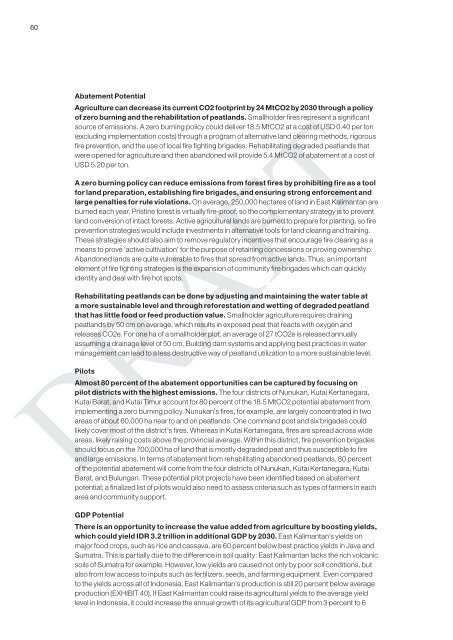East Kalimantan Environmentally Sustainable Development Strategy
East Kalimantan Environmentally Sustainable Development Strategy
East Kalimantan Environmentally Sustainable Development Strategy
You also want an ePaper? Increase the reach of your titles
YUMPU automatically turns print PDFs into web optimized ePapers that Google loves.
60<br />
Abatement Potential<br />
Agriculture can decrease its current CO2 footprint by 24 MtCO2 by 2030 through a policy<br />
of zero burning and the rehabilitation of peatlands. Smallholder fires represent a significant<br />
source of emissions. A zero burning policy could deliver 18.5 MtCO2 at a cost of USD 0.40 per ton<br />
(excluding implementation costs) through a program of alternative land clearing methods, rigorous<br />
fire prevention, and the use of local fire fighting brigades. Rehabilitating degraded peatlands that<br />
were opened for agriculture and then abandoned will provide 5.4 MtCO2 of abatement at a cost of<br />
USD 5.20 per ton.<br />
A zero burning policy can reduce emissions from forest fires by prohibiting fire as a tool<br />
for land preparation, establishing fire brigades, and ensuring strong enforcement and<br />
large penalties for rule violations. On average, 250,000 hectares of land in <strong>East</strong> <strong>Kalimantan</strong> are<br />
burned each year. Pristine forest is virtually fire-proof, so the complementary strategy is to prevent<br />
land conversion of intact forests. Active agricultural lands are burned to prepare for planting, so fire<br />
prevention strategies would include investments in alternative tools for land clearing and training.<br />
These strategies should also aim to remove regulatory incentives that encourage fire clearing as a<br />
means to prove ‘active cultivation’ for the purpose of retaining concessions or proving ownership.<br />
Abandoned lands are quite vulnerable to fires that spread from active lands. Thus, an important<br />
element of fire fighting strategies is the expansion of community fire brigades which can quickly<br />
identity and deal with fire hot spots.<br />
Rehabilitating peatlands can be done by adjusting and maintaining the water table at<br />
a more sustainable level and through reforestation and wetting of degraded peatland<br />
that has little food or feed production value. Smallholder agriculture requires draining<br />
peatlands by 50 cm on average, which results in exposed peat that reacts with oxygen and<br />
releases CO2e. For one ha of a smallholder plot, an average of 27 tCO2e is released annually<br />
assuming a drainage level of 50 cm. Building dam systems and applying best practices in water<br />
management can lead to a less destructive way of peatland utilization to a more sustainable level.<br />
Pilots<br />
Almost 80 percent of the abatement opportunities can be captured by focusing on<br />
pilot districts with the highest emissions. The four districts of Nunukan, Kutai Kertanegara,<br />
Kutai Barat, and Kutai Timur account for 80 percent of the 18.5 MtCO2 potential abatement from<br />
implementing a zero burning policy. Nunukan’s fires, for example, are largely concentrated in two<br />
areas of about 60,000 ha near to and on peatlands. One command post and six brigades could<br />
likely cover most of the district’s fires. Whereas in Kutai Kertanegara, fires are spread across wide<br />
areas, likely raising costs above the provincial average. Within this district, fire prevention brigades<br />
should focus on the 700,000 ha of land that is mostly degraded peat and thus susceptible to fire<br />
and large emissions. In terms of abatement from rehabilitating abandoned peatlands, 80 percent<br />
of the potential abatement will come from the four districts of Nunukan, Kutai Kertanegara, Kutai<br />
Barat, and Bulungan. These potential pilot projects have been identified based on abatement<br />
potential; a finalized list of pilots would also need to assess criteria such as types of farmers in each<br />
area and community support.<br />
DRAFT<br />
GDP Potential<br />
There is an opportunity to increase the value added from agriculture by boosting yields,<br />
which could yield IDR 3.2 trillion in additional GDP by 2030. <strong>East</strong> <strong>Kalimantan</strong>’s yields on<br />
major food crops, such as rice and cassava, are 60 percent below best practice yields in Java and<br />
Sumatra. This is partially due to the difference in soil quality: <strong>East</strong> <strong>Kalimantan</strong> lacks the rich volcanic<br />
soils of Sumatra for example. However, low yields are caused not only by poor soil conditions, but<br />
also from low access to inputs such as fertilizers, seeds, and farming equipment. Even compared<br />
to the yields across all of Indonesia, <strong>East</strong> <strong>Kalimantan</strong>’s production is still 20 percent below average<br />
production (EXHIBIT 40). If <strong>East</strong> <strong>Kalimantan</strong> could raise its agricultural yields to the average yield<br />
level in Indonesia, it could increase the annual growth of its agricultural GDP from 3 percent to 6

















